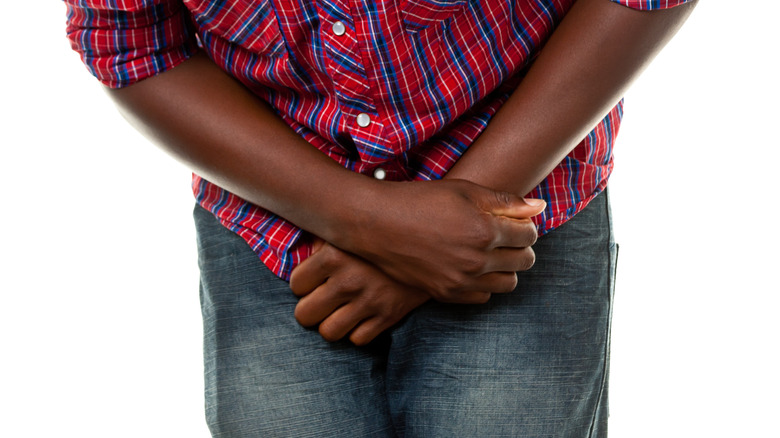What It Means When Men Experience A Split-Stream While Peeing
Seeing your pee split in two and make a mess all over the toilet bowl can sound like an amusing anecdote, but there are several different reasons why this happens in men. Some are not so serious, while others fall under the category of pee symptoms men really shouldn't ignore.
Under the umbrella of harmless causes are adhesions, which occur when the edges of your urethra get stuck together temporarily. This can happen owing to the simple reason that men release semen and urine through the same opening. When you forget to pee after masturbating or if semen doesn't completely come out, dried-up ejaculate can cause a sticky situation that leads to adhesions and results in a split-stream. This usually clears up within a day or two.
Additionally, having an uncircumcised penis can cause the foreskin to get stuck on the urethral meatus (the opening from the inside to the outside at the end of your urethra), explained urologist and pelvic surgeon Dr. Rena Malik (via YouTube). "[This can happen] because of friction from your underwear or friction from recently having sex." Gently retracting the foreskin before peeing can help avoid split-stream, but it's important to put it back where it's supposed to be, added the doctor. "Otherwise, you can develop what's called a paraphimosis, which is when that foreskin gets stuck and then you have to go to the emergency room to get that reduced." Ouch.
Other serious reasons for your pee splitting in two
You can experience split-stream if you're diagnosed with an enlarged prostate too. An enlarged prostate is something that happens with age for most men. Changes in testicular cells and testosterone levels are thought to be some of the causes. Your prostate, the walnut-sized gland, sits very close to your urethra, so an enlarged one can put stress on your urethra, narrowing the flow and leading to a split-stream. Other possible reasons for a split-pee are urethral stricture, meatal stenosis, phimosis, passing small kidney stones, genital warts, urethral polyps (although this is more common in women than men), prostatitis, and urinary tract infections (UTI).
A urethral stricture is when your urethra becomes narrowed because of long-term inflammation, some kind of trauma, or sexually transmitted infections (STI) that cause strictures. Surgical procedures or placing a catheter in your bladder through your urethra can be culprits too. Meatal stenosis is more common in circumcised phalluses. It is an abnormal narrowing of the urethral meatus brought on by irritating effects of urine or friction against clothing. Phimosis is a condition where men are unable to retract the foreskin covering the tip of their penis. The tight foreskin can appear like a rubber band and can result in a split-stream. Passing the small remnants of kidney stones can result in your pee slitting too. One of the most common forms of STIs, genital warts, can be to blame as well. Prostatitis is a disorder that results in inflammation of the prostate, and spraying urine can be one symptom.
What do do about split-stream urine
While some of the reasons will resolve on their own, others might require professional help. An enlarged prostate, for example, can become problematic if it's affecting your quality of life. The condition has other symptoms like being unable to pee, being unable to fully empty your bladder, painful or bloody urine, frequent urination, and incontinence. There are many treatment options, including medication, surgery, and newer approaches to treating the condition.
Treating a urethral stricture can involve surgical procedures to help widen the urethra, such as dilation, urethroplasty, and endoscopic urethrotomy. Meatoplasty, a surgery to widen the urethral meatus, might follow a meatal stenosis diagnosis, whereas phimosis can be treated with steroid creams and gentle manipulation of the foreskin. Surgery is an option here too. Genital warts can be treated with ointments, cryotherapy, and sometimes surgical removal of the warts. In the case of prostatitis, treating the infection itself via antibiotics and managing pain and urinary symptoms is what your doctor may recommend. UTIs and kidney stones have their own treatment protocols.
It is important to watch your split-stream pee and see how long it lasts, and to also keep an eye out for other symptoms. For example, in the case of a urethral stricture, you might also experience painful or difficult urination, and with meatal stenosis, there'll be bloody urine or incontinence. Phimosis might present as redness, soreness, and swelling, while prostatitis and kidney stones could cause back pain. If your split-stream symptom lasts for more than two days, you're better off seeing a doctor about it.



